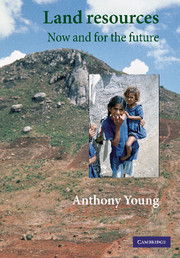Book contents
- Frontmatter
- Contents
- Preface
- Acknowledgements
- Note on acronyms and currency
- 1 Concern for land
- 2 Land resource issues
- 3 Resource survey and land evaluation
- 4 Competition for land
- 5 Working with farmers
- 6 Land use planning
- 7 Land degradation
- 8 Global issues: climatic change and biodiversity
- 9 Monitoring change: land resource indicators
- 10 Costing the earth: the economic value of land resources
- 11 Land management: caring for resources
- 12 Research and technology
- 13 Land, food, and people
- 14 Population, poverty, and conflict
- 15 Awareness, attitudes, and action
- Notes
- References
- Index
10 - Costing the earth: the economic value of land resources
Published online by Cambridge University Press: 04 August 2010
- Frontmatter
- Contents
- Preface
- Acknowledgements
- Note on acronyms and currency
- 1 Concern for land
- 2 Land resource issues
- 3 Resource survey and land evaluation
- 4 Competition for land
- 5 Working with farmers
- 6 Land use planning
- 7 Land degradation
- 8 Global issues: climatic change and biodiversity
- 9 Monitoring change: land resource indicators
- 10 Costing the earth: the economic value of land resources
- 11 Land management: caring for resources
- 12 Research and technology
- 13 Land, food, and people
- 14 Population, poverty, and conflict
- 15 Awareness, attitudes, and action
- Notes
- References
- Index
Summary
Despite growing recognition of the importance of environmental criteria, many investment decisions by development agencies are taken primarily on grounds of economics, and, specifically, on returns to investment. If natural resource considerations are to be allotted their rightful importance, there is no avoiding their conversion into money terms. Economic values are needed for analysis of soil and other land conservation projects, for estimating the loss to society caused by land degradation, and for national environmental accounting. Conventional economic methods undervalue natural resources; they may appear to come free, or to be priced at either their marginal or average values, ignoring the far higher price that would be paid if they became scarce. Above all, the practice of discounting, as employed in cost–benefit analysis, grossly underestimates future option values, the value of resources for use in the future. A consequence is that the economic losses caused by erosion, salinization, and other kinds of degradation are greatly undervalued. Economic methods as currently applied give equal weight to the needs of today's poor, but they steal resources, and thus welfare, from future generations. Assigning a value to land resources equal to their productive potential for at least 500 years, which virtually amounts to a sustainability constraint, would help to remedy this iniquitous situation.
Is it necessary, useful, or possible to assign an economic value to soils, water, forests, and pastures? There are certainly difficulties in doing so, and the first point to consider is whether it needs to be done at all.
- Type
- Chapter
- Information
- Land ResourcesNow and for the Future, pp. 154 - 178Publisher: Cambridge University PressPrint publication year: 1998



